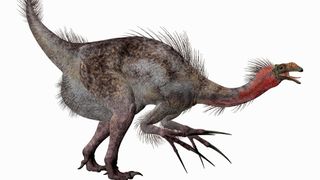Jurassic World’s bizarre, scythe-clawed dinosaur couldn't have been a slasher, study confirms
Scientists have confirmed that Therizinosaurus, the scythe-clawed dinosaur from Jurassic World, couldn't have used its 'useless' gigantic claws to fight because they were too flimsy.

An "utterly bizarre" dinosaur with claws so gigantic that their function has long remained a mystery couldn't use them to fight or fend off attackers because they were too flimsy, a new study has found.
The theropod dinosaur, Therizinosaurus, lived in the Late Triassic and Cretaceous (220 million to 66 million years ago). Its scythe-like claws feature in the latest "Jurassic World" movie, where the beast can be seen batting away a deer and impaling the ferocious predator Giganotosaurus. However, the new research indicates that this depiction is inaccurate.
"Movies and documentaries suggest that they used these claws like long swords to fight each other or predators," Zichuan Qin, a doctoral student at the University of Bristol in England who led the study, told Live Science. "But our research suggests that they cannot bear any stress, which means these animals couldn't use their claws to fight or defend themselves. The results surprised all of us, because we watched ["Jurassic World: Dominion"] last year and everyone got excited. We quickly realized, 'No, that's not true!'"
Therizinosaurs started off turkey-size and evolved to be 30 feet (10 meters) tall, as big as Tyrannosaurus rex. By the end of the Cretaceous, this "utterly bizarre" feathered dinosaur looked "kind of like a giraffe" with short legs and a "huge bottom," which it might have sat on while munching leaves, the researchers said.
But what made this dinosaur a real showstopper was its narrow, 3-foot-long (1 m) "Edward Scissorhands" claws — the biggest of any animal ever recorded, according to the study.
Related: Dinosaur 'reaper' with massive claws found in Japan
"There's been a lot of argument about what these claws were for, partly because they're so large and partly because they're attached to an animal whose other features suggest it was a herbivore — their skulls and their teeth suggest they were plant eaters," Paul Barrett, a paleobiologist at the Natural History Museum in London who was not involved in the study, told Live Science.
Sign up for the Live Science daily newsletter now
Get the world’s most fascinating discoveries delivered straight to your inbox.
These disproportionate claws were so weak that they couldn't even hook and pull down branches, according to the study, published Feb. 16 in the journal Communications Biology. The researchers used detailed scans of fossils to make 3D computer models of the claws, which they tested for different mechanical functions, such as digging, pulling and piercing.
They also studied alvarezsaurs, a group of dinosaurs closely related to therizinosaurs that, in contrast to the latter group, evolved to become miniature dinosaurs with rock-pick-like claws. "The alvarezsaurs became the tiniest dinosaurs ever — smaller than a chicken," Qin said. "Their claws were small but very strong and robust; they could bear very large stress, like digging in the ground."
The idea that Alvarezsaurus was an ant eater with claws ideally suited to digging up anthills is widely accepted among paleontologists, but the new study provides more rigorous and quantitative support, Barrett said.
So why did Therizinosaurus evolve seemingly useless, gigantic claws? The researchers suggested that males showed off their long claws to attract females, much like peacocks unfold their tails to impress potential mates.
"We conclude they were largely for display," study co-author Mike Benton, a professor of vertebrate paleontology at the University of Bristol, told Live Science in an email. "Therizinosaurs maybe flashed and clacked their long claws as a means to scare others or to impress females."
The authors presented a convincing case ruling out the use of these flimsy claws for fighting, Barrett said. However, "they might have had some minor role in food gathering," he added. "But very often in evolution, these very weird and elaborate structures that look useless generally come down to display and who gets to mate with who."
He also suggested another possible purpose for the gigantic claws. "They might even have used them to groom each other. These animals were feathered, and for all we know, they could have used them like elaborate combs."

Sascha is a U.K.-based trainee staff writer at Live Science. She holds a bachelor’s degree in biology from the University of Southampton in England and a master’s degree in science communication from Imperial College London. Her work has appeared in The Guardian and the health website Zoe. Besides writing, she enjoys playing tennis, bread-making and browsing second-hand shops for hidden gems.